weight FORD MUSTANG 2003 4.G Owners Manual
[x] Cancel search | Manufacturer: FORD, Model Year: 2003, Model line: MUSTANG, Model: FORD MUSTANG 2003 4.GPages: 256, PDF Size: 2.4 MB
Page 123 of 256
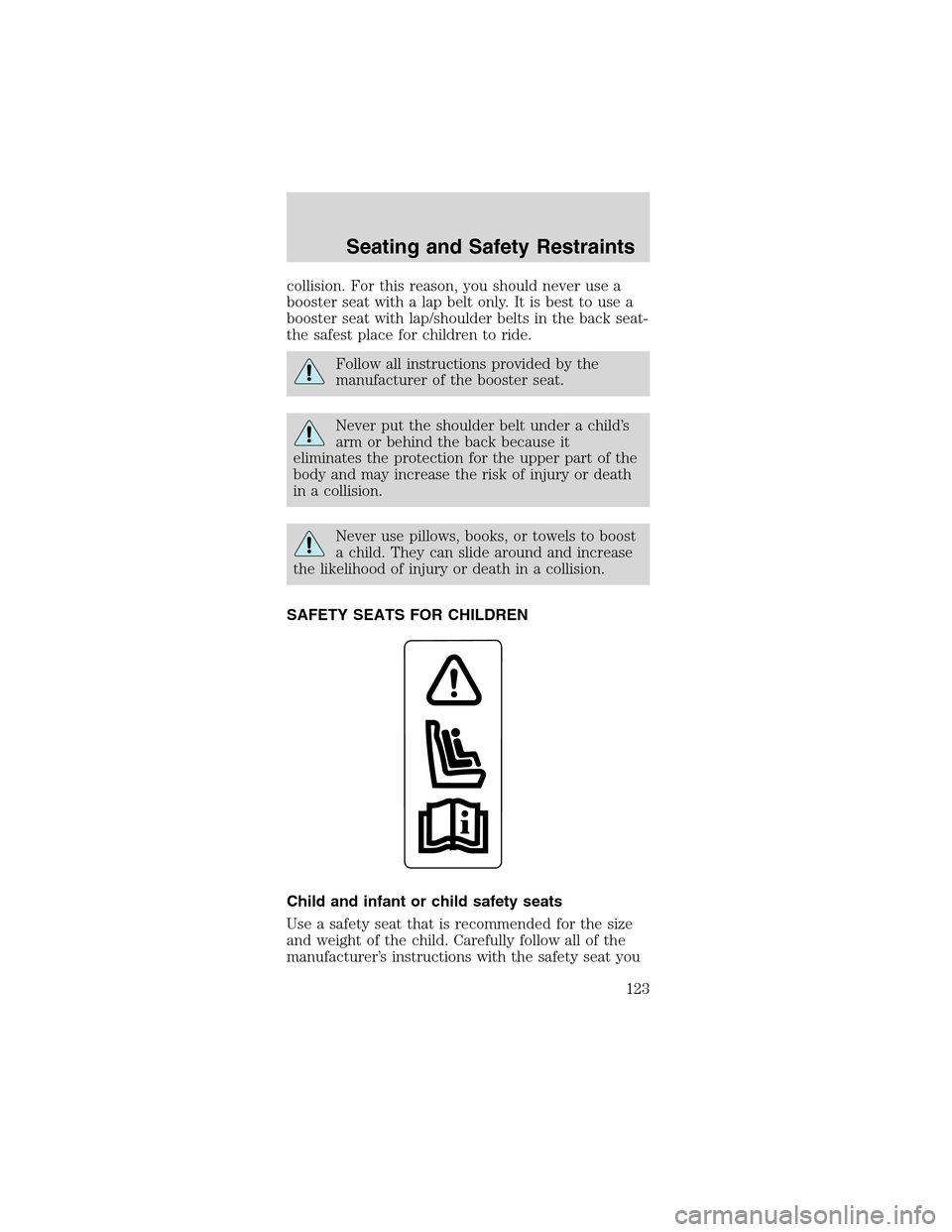
collision. For this reason, you should never use a
booster seat with a lap belt only. It is best to use a
booster seat with lap/shoulder belts in the back seat-
the safest place for children to ride.
Follow all instructions provided by the
manufacturer of the booster seat.
Never put the shoulder belt under a child’s
arm or behind the back because it
eliminates the protection for the upper part of the
body and may increase the risk of injury or death
in a collision.
Never use pillows, books, or towels to boost
a child. They can slide around and increase
the likelihood of injury or death in a collision.
SAFETY SEATS FOR CHILDREN
Child and infant or child safety seats
Use a safety seat that is recommended for the size
and weight of the child. Carefully follow all of the
manufacturer’s instructions with the safety seat you
Seating and Safety Restraints
123
Page 154 of 256
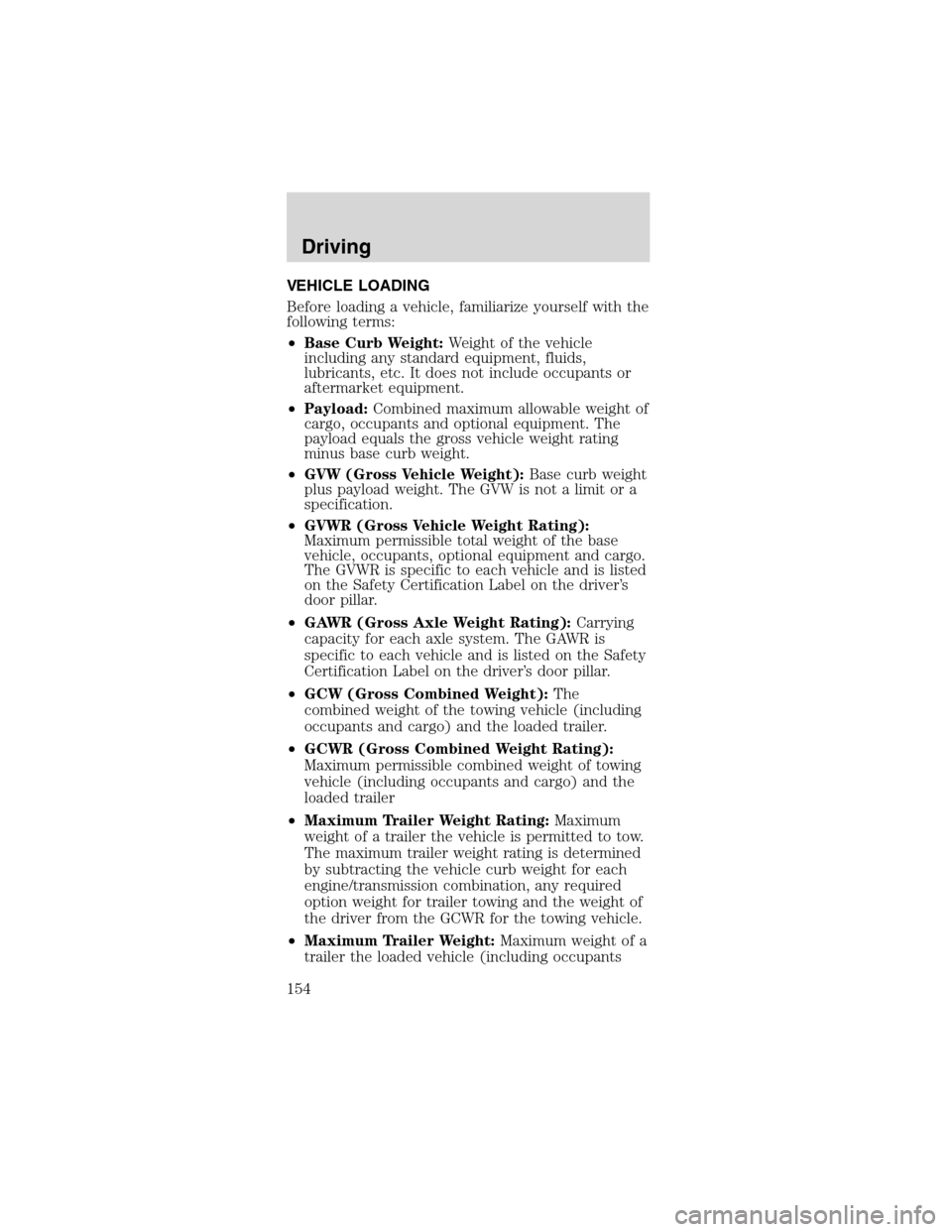
VEHICLE LOADING
Before loading a vehicle, familiarize yourself with the
following terms:
•Base Curb Weight:Weight of the vehicle
including any standard equipment, fluids,
lubricants, etc. It does not include occupants or
aftermarket equipment.
•Payload:Combined maximum allowable weight of
cargo, occupants and optional equipment. The
payload equals the gross vehicle weight rating
minus base curb weight.
•GVW (Gross Vehicle Weight):Base curb weight
plus payload weight. The GVW is not a limit or a
specification.
•GVWR (Gross Vehicle Weight Rating):
Maximum permissible total weight of the base
vehicle, occupants, optional equipment and cargo.
The GVWR is specific to each vehicle and is listed
on the Safety Certification Label on the driver’s
door pillar.
•GAWR (Gross Axle Weight Rating):Carrying
capacity for each axle system. The GAWR is
specific to each vehicle and is listed on the Safety
Certification Label on the driver’s door pillar.
•GCW (Gross Combined Weight):The
combined weight of the towing vehicle (including
occupants and cargo) and the loaded trailer.
•GCWR (Gross Combined Weight Rating):
Maximum permissible combined weight of towing
vehicle (including occupants and cargo) and the
loaded trailer
•Maximum Trailer Weight Rating:Maximum
weight of a trailer the vehicle is permitted to tow.
The maximum trailer weight rating is determined
by subtracting the vehicle curb weight for each
engine/transmission combination, any required
option weight for trailer towing and the weight of
the driver from the GCWR for the towing vehicle.
•Maximum Trailer Weight:Maximum weight of a
trailer the loaded vehicle (including occupants
Driving
154
Page 155 of 256
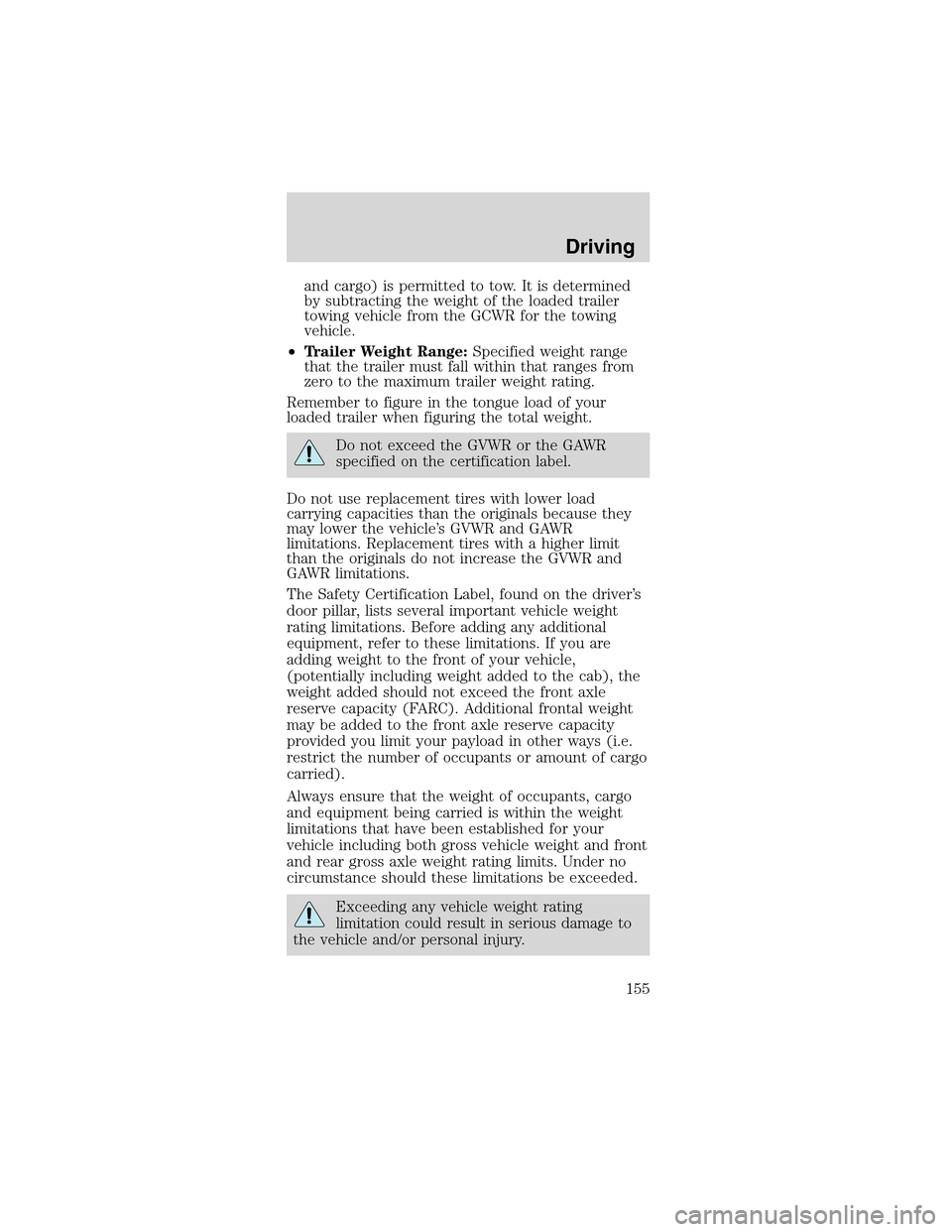
and cargo) is permitted to tow. It is determined
by subtracting the weight of the loaded trailer
towing vehicle from the GCWR for the towing
vehicle.
•Trailer Weight Range:Specified weight range
that the trailer must fall within that ranges from
zero to the maximum trailer weight rating.
Remember to figure in the tongue load of your
loaded trailer when figuring the total weight.
Do not exceed the GVWR or the GAWR
specified on the certification label.
Do not use replacement tires with lower load
carrying capacities than the originals because they
may lower the vehicle’s GVWR and GAWR
limitations. Replacement tires with a higher limit
than the originals do not increase the GVWR and
GAWR limitations.
The Safety Certification Label, found on the driver’s
door pillar, lists several important vehicle weight
rating limitations. Before adding any additional
equipment, refer to these limitations. If you are
adding weight to the front of your vehicle,
(potentially including weight added to the cab), the
weight added should not exceed the front axle
reserve capacity (FARC). Additional frontal weight
may be added to the front axle reserve capacity
provided you limit your payload in other ways (i.e.
restrict the number of occupants or amount of cargo
carried).
Always ensure that the weight of occupants, cargo
and equipment being carried is within the weight
limitations that have been established for your
vehicle including both gross vehicle weight and front
and rear gross axle weight rating limits. Under no
circumstance should these limitations be exceeded.
Exceeding any vehicle weight rating
limitation could result in serious damage to
the vehicle and/or personal injury.
Driving
155
Page 222 of 256
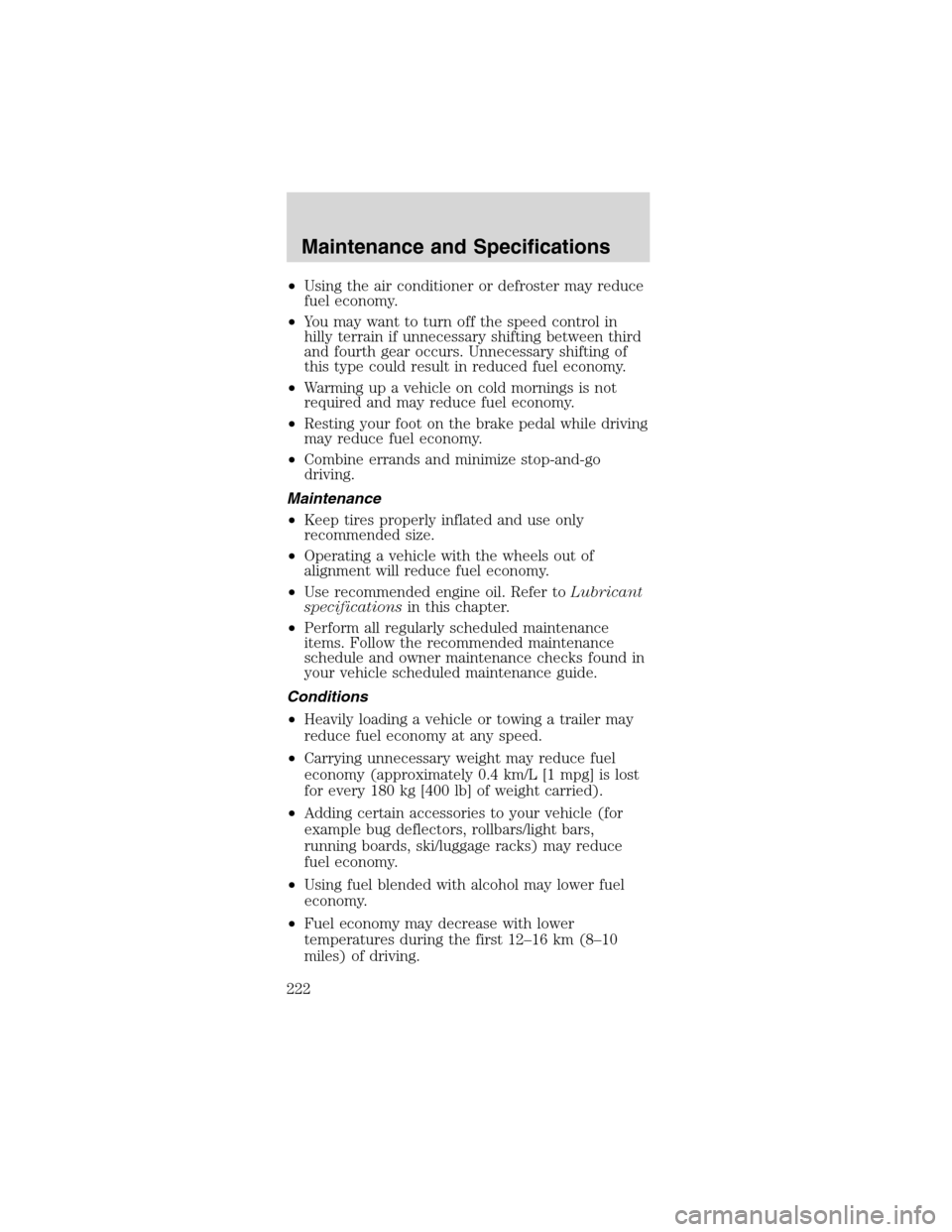
•Using the air conditioner or defroster may reduce
fuel economy.
•You may want to turn off the speed control in
hilly terrain if unnecessary shifting between third
and fourth gear occurs. Unnecessary shifting of
this type could result in reduced fuel economy.
•Warming up a vehicle on cold mornings is not
required and may reduce fuel economy.
•Resting your foot on the brake pedal while driving
may reduce fuel economy.
•Combine errands and minimize stop-and-go
driving.
Maintenance
•Keep tires properly inflated and use only
recommended size.
•Operating a vehicle with the wheels out of
alignment will reduce fuel economy.
•Use recommended engine oil. Refer toLubricant
specificationsin this chapter.
•Perform all regularly scheduled maintenance
items. Follow the recommended maintenance
schedule and owner maintenance checks found in
your vehicle scheduled maintenance guide.
Conditions
•Heavily loading a vehicle or towing a trailer may
reduce fuel economy at any speed.
•Carrying unnecessary weight may reduce fuel
economy (approximately 0.4 km/L [1 mpg] is lost
for every 180 kg [400 lb] of weight carried).
•Adding certain accessories to your vehicle (for
example bug deflectors, rollbars/light bars,
running boards, ski/luggage racks) may reduce
fuel economy.
•Using fuel blended with alcohol may lower fuel
economy.
•Fuel economy may decrease with lower
temperatures during the first 12–16 km (8–10
miles) of driving.
Maintenance and Specifications
222
Page 247 of 256
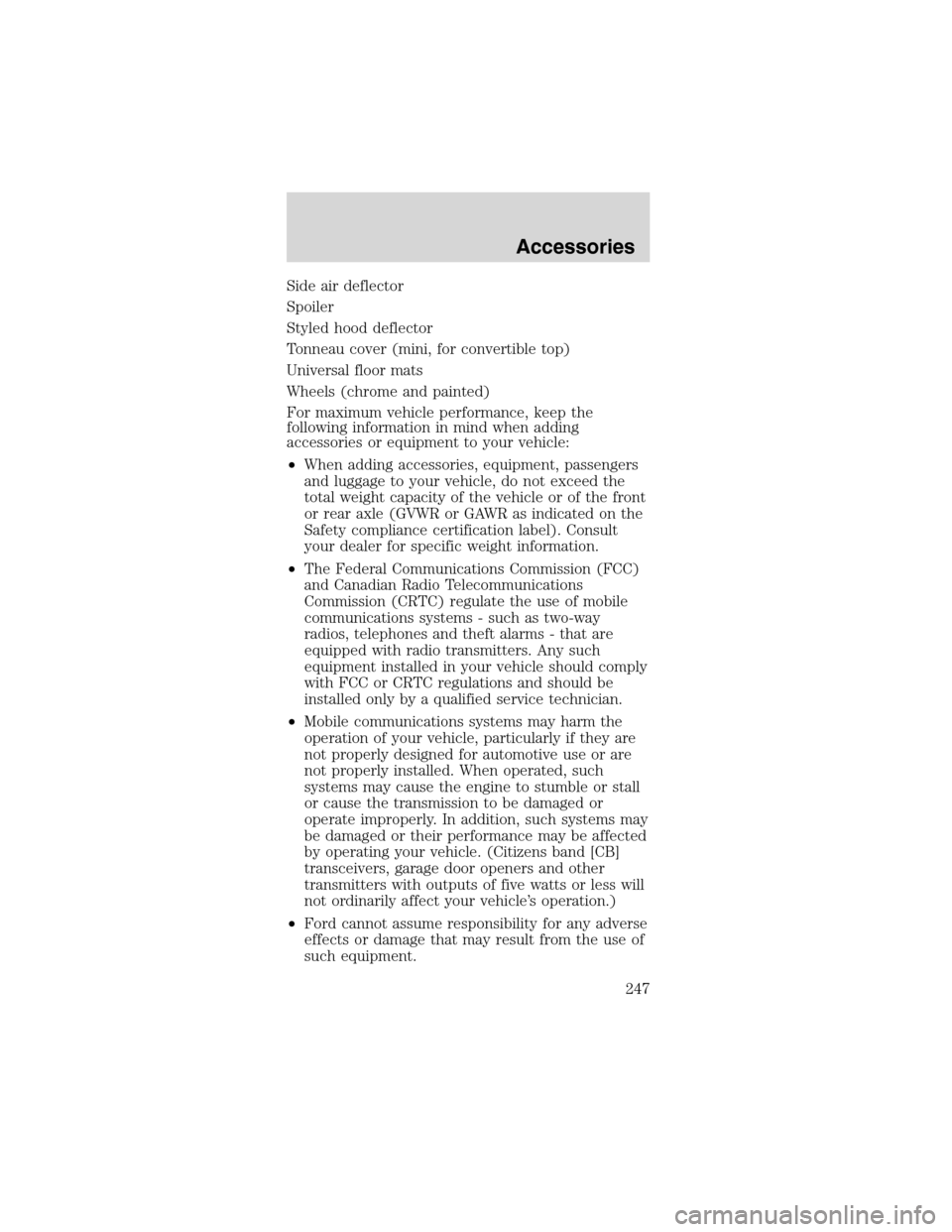
Sideair deflector
Spoiler
Styled hood deflector
Tonneau cover (mini, for convertible top)
Universal floor mats
Wheels (chrome and painted)
For maximum vehicle performance, keep the
following information in mind when adding
accessories or equipment to your vehicle:
•When adding accessories, equipment, passengers
and luggage to your vehicle, do not exceed the
total weight capacity of the vehicle or of the front
or rear axle (GVWR or GAWR as indicated on the
Safety compliance certification label). Consult
your dealer for specific weight information.
•The Federal Communications Commission (FCC)
and Canadian Radio Telecommunications
Commission (CRTC) regulate the use of mobile
communications systems - such as two-way
radios, telephones and theft alarms - that are
equipped with radio transmitters. Any such
equipment installed in your vehicle should comply
with FCC or CRTC regulations and should be
installed only by a qualified service technician.
•Mobile communications systems may harm the
operation of your vehicle, particularly if they are
not properly designed for automotive use or are
not properly installed. When operated, such
systems may cause the engine to stumble or stall
or cause the transmission to be damaged or
operate improperly. In addition, such systems may
be damaged or their performance may be affected
by operating your vehicle. (Citizens band [CB]
transceivers, garage door openers and other
transmitters with outputs of five watts or less will
not ordinarily affect your vehicle’s operation.)
•Ford cannot assume responsibility for any adverse
effects or damage that may result from the use of
such equipment.
Accessories
247
Page 251 of 256
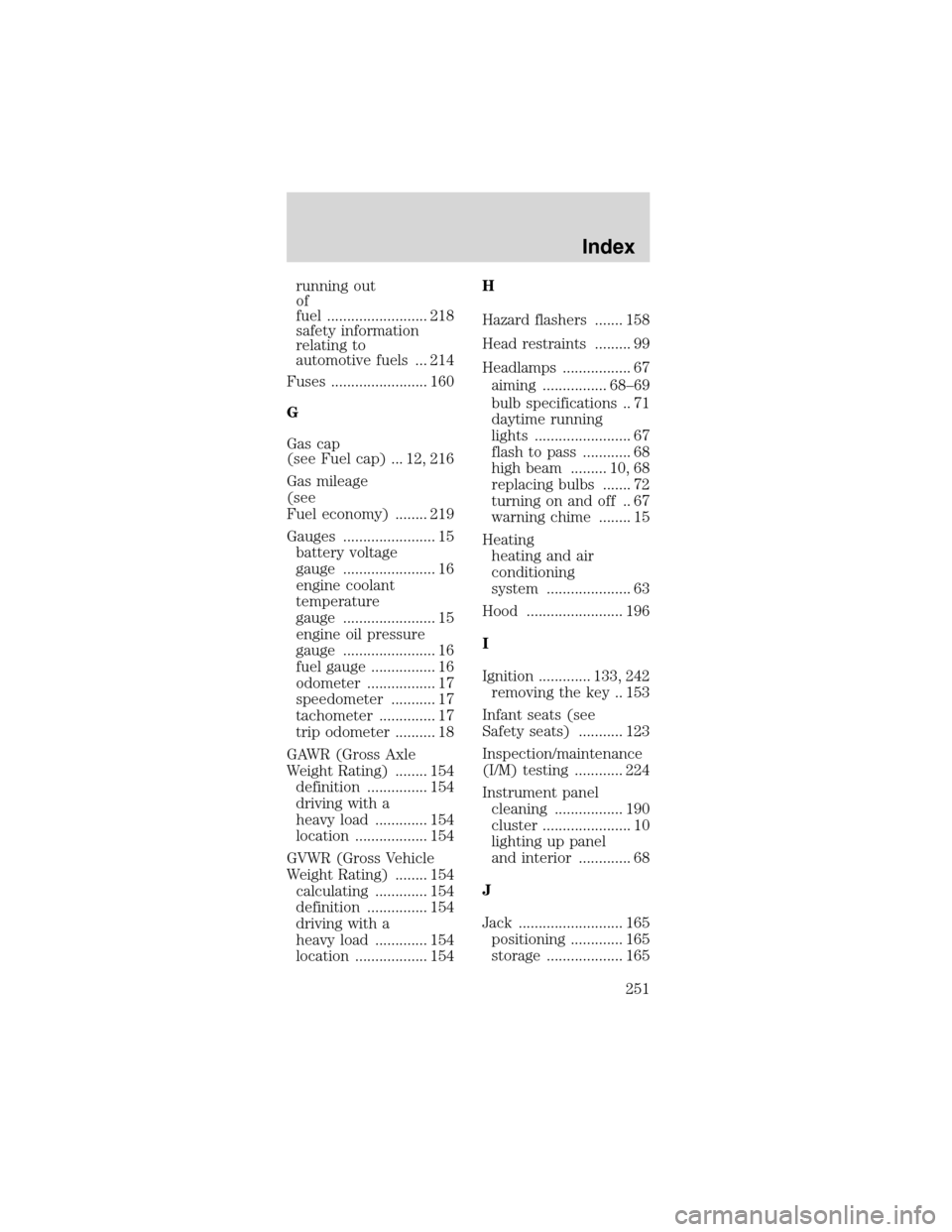
running out
of
fuel ......................... 218
safety information
relating to
automotive fuels ... 214
Fuses ........................ 160
G
Gas cap
(see Fuel cap) ... 12, 216
Gas mileage
(see
Fuel economy) ........ 219
Gauges ....................... 15
battery voltage
gauge ....................... 16
engine coolant
temperature
gauge ....................... 15
engine oil pressure
gauge ....................... 16
fuel gauge ................ 16
odometer ................. 17
speedometer ........... 17
tachometer .............. 17
trip odometer .......... 18
GAWR (Gross Axle
Weight Rating) ........ 154
definition ............... 154
driving with a
heavy load ............. 154
location .................. 154
GVWR (Gross Vehicle
Weight Rating) ........ 154
calculating ............. 154
definition ............... 154
driving with a
heavy load ............. 154
location .................. 154H
Hazard flashers ....... 158
Head restraints ......... 99
Headlamps ................. 67
aiming ................ 68–69
bulb specifications .. 71
daytime running
lights ........................ 67
flash to pass ............ 68
high beam ......... 10, 68
replacing bulbs ....... 72
turning on and off .. 67
warning chime ........ 15
Heating
heating and air
conditioning
system ..................... 63
Hood ........................ 196
I
Ignition ............. 133, 242
removing the key .. 153
Infant seats (see
Safety seats) ........... 123
Inspection/maintenance
(I/M) testing ............ 224
Instrument panel
cleaning ................. 190
cluster ...................... 10
lighting up panel
and interior ............. 68
J
Jack .......................... 165
positioning ............. 165
storage ................... 165
Index
251